One would think a lonesome bike hermit would have desert travel down to a science.
One would be wrong. Sunburned skin on my forehead and nose is flaking off a week after the Owyhee Uplands tour. There were blisters on the backs of my hands after the first day. SPF 33 sunscreen is no match for the desert sun at a mile above sea level. Hands, arms, legs, the back of the neck, ears and noses need to be physically shaded via long sleeve shirts, pants and hats. Desert dwellers in Mexico, North Africa and the Middle East know this, and they know that loose fitting full coverage clothing actually keeps them cooler than say, cutoffs and t-shirts. The air circulates next to the skin under the garment and evaporates the sweat- that’s a pretty neat physiological design.
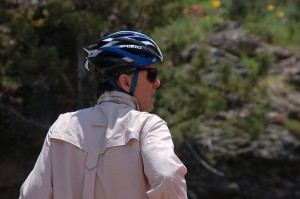
This shirt- my "safari" shirt- is made of synthetic material and has a vented yoke. The collar folds up too.

I invented this. I am going to call it the Ultra-Light Power-Screen. I'm going to write a business plan and put it on KickStarter to raise money and go into production. Soon.
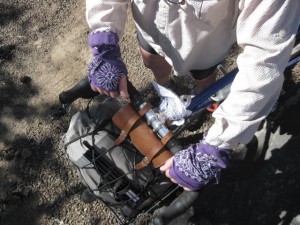
I fashioned these mitts out of a bandana to screen the backs of my hands and my wrists from the sun.
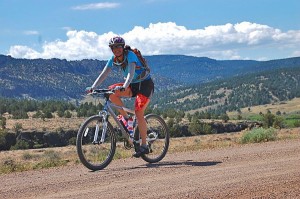
Lisa, who has extensive adventure travel experience, came up with a solution to keep the sun off her thighs. I tried it and it actually works better than you might think- when riding, the wind presses the bandana down and keeps it in place.
For my birthday Sky King bought me a Click-Stand.
I had a good opportunity to test it with a loaded bike, and I have to say it solves the problem of what to do with the bike when taking a break. The Click-Stand is a portable, folding bicycle stand which, when folded, is between seven and ten inches in length. Mine weighs about 110 grams. For ultra-light touring the Click-Stand could double as a support for a rain fly or shelter. When used as a bike stand, the maker recommends using the supplied, small bungie straps to hold the brake levers closed so the bike won’t roll off the stand. I will not contradict that, but I can say that simply strapping a toe clip strap around the down tube and front tire to keep the wheel from turning works too.
Using a traditional kickstand is possible with a loaded touring bike but one needs to be careful. The type of kickstand that is held in place by sandwiching the chainstays between two plates with a bolt through the middle can actually crush the chain stays, especially the more ubiquitous, one legged kickstand. A two-legged kickstand is better. Such a design helps reduce the potential for chainstay flex compared to that which a loaded bike leaning on a kickstand single leg can impose. Even so, care needs to be taken not to tighten the sandwich bolt too tight. And the bolt needs to be checked regularly to make sure it is not coming loose. One bonus of the two-legged design is that the rear wheel is held a little ways off the ground, making maintenance and repairs much easier.
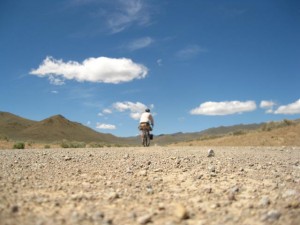
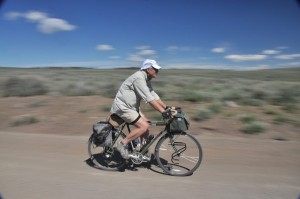
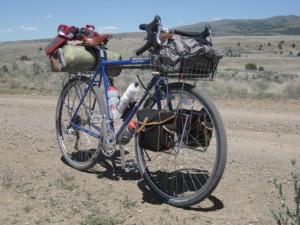
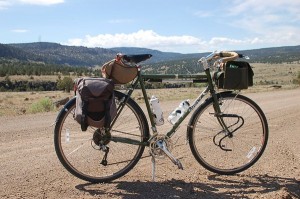
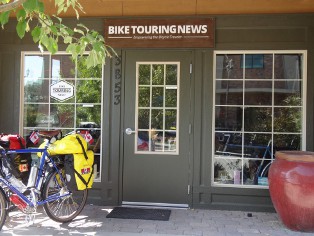
Hans Erdman June 10, 2012, 10:31 am
I have a bunch of jerseys, mostly for mountain biking but some road jerseys for clubs I belong to and my fantastic, treasured Adventure Cycling long-sleeve (spring and fall) jersey. Great design and very functional!
Anyhow, to the point, I have always worn “expedition” shirts (Cabela’s sells them as “fishing” shirts) when touring. Usually yellow for visibility and a certain amount on reflecting the sun’s rays. The shirts are very breathable, light weight and rated 45 or better for sun protection. I also like having pockets to put things in, if needed.
Ride safe,
Hans
St. Brendan’s Two-Wheeled Explorer
Bike Hermit June 10, 2012, 3:50 pm
Right, “fishing shirts”. I have a Bass Pro Shops catalog and have looked at the shirts with UPF Sun Protection (ultraviolet protection factor) Wikipedia says- “Factors that affect the level of sun protection provided by a fabric, in approximate order of importance, include weave, color, weight, stretch, and wetness. In addition, UV absorbers may be added at various points in the manufacturing process to enhance UV protection levels. The more open/less dense the fabric, the worse the protection(weave weight stretch).The darker the color, the more dye, the better the protection. Getting a fabric wet reduces the protection as much as half except for silk and viscose which can get more protective when wet. Polyester contains an ester(benzene) ring that absorbs UV light.
There is some indication that washing fabrics in detergents containing fabric brighteners, which absorb UV radiation, might increase their protective capability. Studies at the University of Alberta also suggest that darker colored fabrics can offer more protection than lighter colored fabrics”
Bass Pro Shops also has sun gloves with extra long cuffs, sun masks and sun hoods which can cover the entire face and fit under a helmet. And their nylon angler pants might make good touring pants if they have a gusseted crotch. Thanks for the comment- now I have some more research to do!
Craig Montgomery June 12, 2012, 8:09 pm
Zinc Oxide is great for the nose and the holes in your gloves. ZINKA out of California (www.zinka.com). I wear long sleeve 100% cotton poplin. Dense weave and really breathes compared to oil-based materials.Wide brimmed desert/jungle hat is better than baseball styles. I learned this the hard was as most of my skin cancers have been burned from my temples.But the secret weapon in my arsenal is long-sleeved silk undershirts from Sierra Trading Post and Cabela’s. These things come tissue thin and make a wonderful base layer and breathe. You can even wear a short sleeve shirt with them.
Craig in Tucson
30 years touring the desert Southwest
http://www.flickr.com/photos/24722971@N05/
Linda Paul June 12, 2012, 9:04 am
So, why not a Grant Peterson seersucker ls shirt? Your Ultra-Light Power Screen is the giraffe’s meow. Tell me, do you make them in extra large?
Bike Hermit June 14, 2012, 12:04 pm
Linda,
These will come in stock sizes and feature an “expanded” geometry making it easier to fit most people. We will need to come up with a way to measure nasal bone height, or N.B.H.